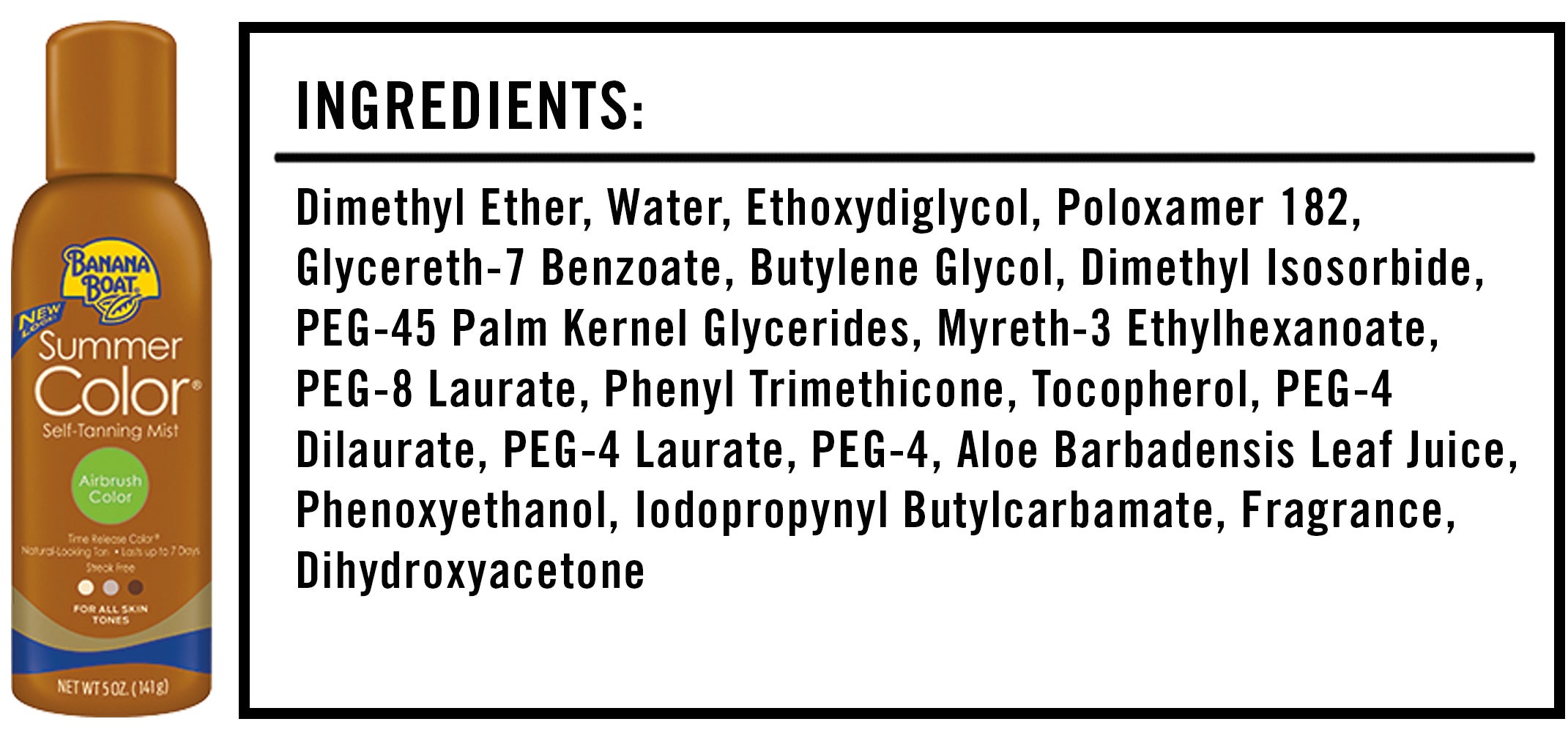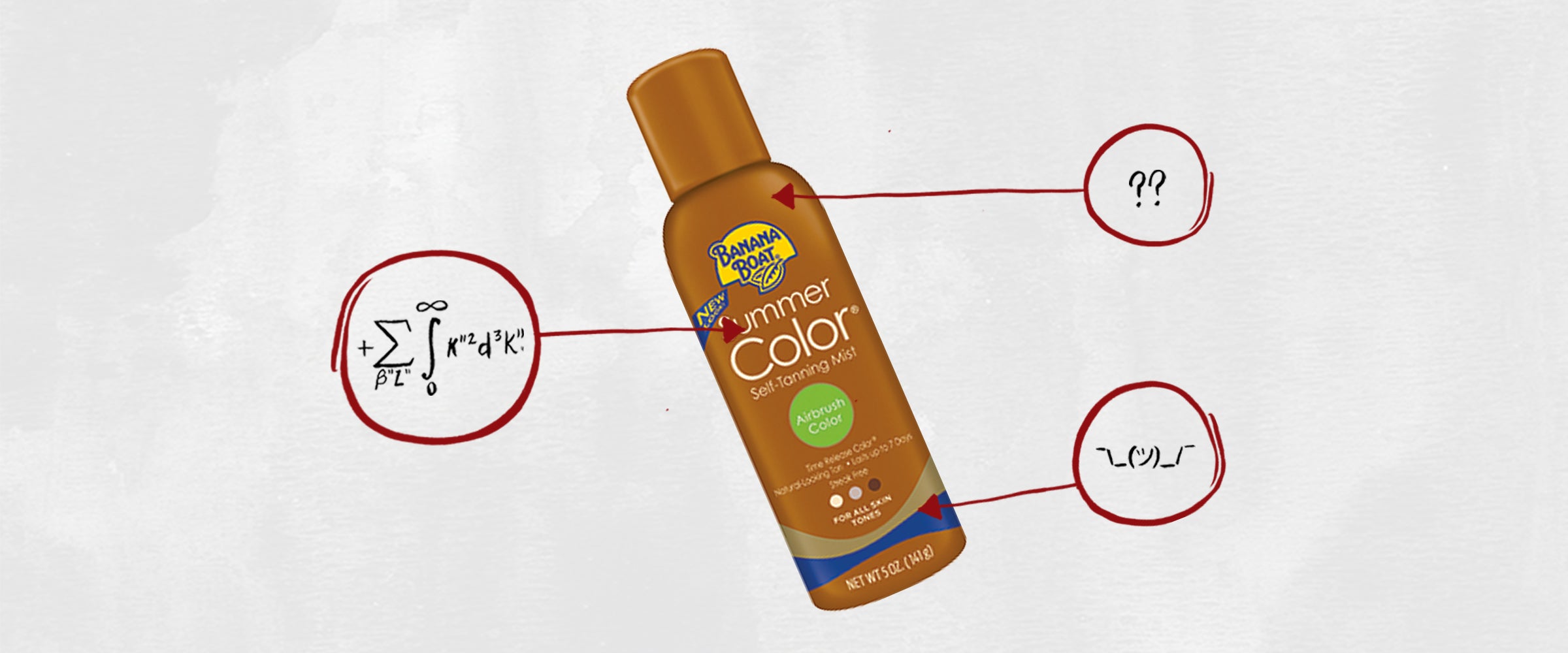We’re often told that you should never eat anything (or put anything on your body) if you don’t recognize everything on the ingredients list. But since most of us have no idea what xanthan gum or potassium benzoate are — or more importantly, what they’re doing to our bodies — we’re decoding the ingredients in the many things Americans put in (and on, or near) themselves.
This edition: Banana Boat Summer Color Self-Tanning Mist, which is made from 20 separate ingredients that we’ve broken down in the exact order they appear on the Walmart website, since the ingredients are nowhere to be found on the Banana boat website.

The Ingredients
1) Dimethyl Ether: Dimethyl ether is a propellant, which means it helps the various ingredients spray out of the bottle. Unfortunately, this ingredient can irritate the skin and is toxic when inhaled. Good thing you literally spray this stuff all around your face and body!
2) Water: This can also be found in the ocean.
3) Ethoxydiglycol: This is a solvent used to thin out the product, which helps it spray from the canister and gives it a lighter feel on the skin. It’s a fairly safe ingredient.
4) Poloxamer 182: This works as an emulsifier, ensuring that the various ingredients in this spray tan mix together properly. Studies suggest that it’s totally safe.
5) Glycereth-7 Benzoate: Glycereth-7 benzoate serves several purposes in cosmetics, but it primarily works as an emollient, which means it conditions the skin by reducing water loss, making it feel softer to the touch.
6) Butylene Glycol: Another solvent, like ethoxydiglycol, butylene glycol helps the other ingredients in this formula mix together and penetrate the skin. In some people, it can irritate the skin and the respiratory passages if inhaled, so, y’know, don’t spray it in your mouth. Otherwise, though, this ingredient is pretty safe.
7) Dimethyl Isosorbide: Similar to butylene glycol and ethoxydiglycol, dimethyl isosorbide is a solvent that helps the active ingredients in this spray tan penetrate the skin. It’s generally regarded as safe, however, like many other ingredients in this spray tan, it can cause mild skin irritation in some people.
8) PEG-45 Palm Kernel Glycerides: Another emulsifier and emollient, PEG-45 palm kernel glycerides, much like everything else covered so far, has the capacity to irritate the skin in some cases.
9) Myreth-3 Ethylhexanoate: Another emollient… nothing to see here.
10) PEG-8 Laurate: This is commonly used in cosmetics as a surfactant, which is similar to an emulsifier in that it helps the ingredients blend together, or as a carrier that helps other ingredients dive deeper into the skin. While there’s some fear surrounding PEGs, since they can be toxic when applied to broken skin, one study concludes, “Taking into consideration all available information from related compounds, as well as the mode and mechanism of action, no safety concern with regard to these endpoints could be identified. Based on the available data it is therefore concluded that PEGs of a wide molecular weight range (200 to over 10,000), their ethers (laureths, ceteths, ceteareths, steareths and oleths), and fatty acid esters (laurates, dilaurates, stearates, distearates) are safe for use in cosmetics.”
All of which is to say, you should still avoid using this spray tan on any cuts.
11) Phenyl Trimethicone: This serves two primary purposes, the first being that it prevents the product from foaming. The second thing phenyl trimethicone does is slow the loss of water from the skin, which should give you a slight sheen.
12) Tocopherol: This is another name for vitamin E, which is believed to protect the skin and provide anti-aging effects. However, as a 2016 study explains, “Despite development of new formulations for use in cosmetics and skin-care products, there is a lack of controlled clinical trials providing a rationale for well-defined dosages and clinical indications for oral and topical vitamin E. After so many years of research on vitamin E, it is still unclear as to whether millions of dollars worth of vitamin E products paid for by patients and consumers have been of any benefit.” In other words, it’s possible that this ingredient does absolutely nothing.
13) PEG-4 Dilaurate: Another emulsifier, PEG-4 dilaurate is obviously another member of the earlier-mentioned PEG family. Another problem with PEGs that people frequently mention is that they sometimes contain dangerous impurities, including the likes of ethylene oxide, which was used in mustard gas during World War I and has been linked to leukemia as well as several types of cancer. So yeah, while the study mentioned earlier seemed to defend PEGs, they’re still worth avoiding if possible.
14) PEG-4 Laurate: See above.
15) PEG-4: See above again.
16) Aloe Barbadensis Leaf Juice: More commonly known as aloe vera, this helps moisturize the skin.
17) Phenoxyethanol: This is a preservative that prevents this spray tan from losing its potency or spoiling; it’s safe in small amounts.
18) Iodopropynyl Butylcarbamate: Another preservative, this ingredient is toxic when inhaled, meaning it probably shouldn’t be used in sprays. Like so many other ingredients on this list, iodopropynyl butylcarbamate also has the potential to cause skin irritation.
19) Fragrance: Because fragrance recipes are considered to be proprietary information, the FDA doesn’t require companies to list the ingredients that make up a fragrance, so this ingredient could very well have another ingredients list all of its own.
None of this necessarily means you should be worried about this ingredient, though. In fact, fragrance ingredients are regulated by the Consumer Product Safety Commission, so theoretically, they should be at least generally safe. That said, fragrances tend to be the leading cause of cosmetic contact dermatitis (i.e., a skin rash caused by contact with a certain substance).
20) Dihydroxyacetone: Finally, we’ve arrived at dihydroxyacetone, the ingredient that darkens the skin. When applied, it reacts with dead cells on the surface of the skin, which leads to the creation of melanoidins, chemicals that cause the appearance of a tan. Fun fact: This is actually the same chemical change that happens during the Maillard Reaction, which produces the quintessential browned color and seared, savory taste of barbecue (and also might cause cancer) when cooking meats.
Unfortunately, there are some problems with dihydroxyacetone, especially when used in spray tans, as one recent study succinctly explains:
“Findings of this integrative review indicate that there is no clear, safe use of DHA-containing sunless tanning products when applied via aerosol delivery systems. It is suggested that an overseeing government body, such as the FDA, should take charge of regulating the use and safety of equipment used to apply self-tanning products via aerosol. It has been posited that chemical reactions that occur during the Maillard reaction caused by DHA in sunless tanning products may cause DNA damage.”
The Takeaway
There are tons of ingredients in this spray tan that are both toxic when inhaled — which is inevitable when you’re spraying your entire body with this stuff — and irritating to the skin. So while there’s no safe way to tan outside, spray tanning has its own set of dangers as well. Sorry, my dudes — guess you’ll just have to learn to accept your pasty skin.

